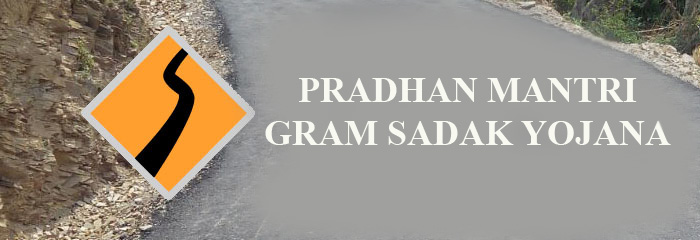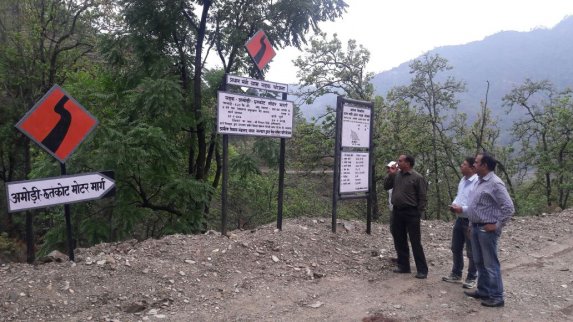- Skip to main content
- Skip to navigation
- Screen Reader Access
- Text Size
- Select Theme Default Theme Yellow Theme Pink Theme Blue Theme
- हिंदी मे

Photo Gallery
- Home
- Organisation
Organization
Organizational Structure of PMGSY under Rural Development,GoU
RESOURCES FOR IMPLEMENTING PMGSY
It is estimated that the total investment required to meet the new connectivity targets is of the order of Rs 79,000 crores with another Rs. 53,000 crore required to upgrade existing rural roads to prescribed standards. In 1999, a one-rupee cess on every litre of diesel and petrol sold was imposed by the Government of India (GoI), and in 2000, a Central Road Fund Act was promulgated to direct the resources obtained through this cess to the improvement of National and State Highways as well as Rural Roads. By law, 50% of the diesel cess is required to be directed towards rural road development. This amounts to about Rs 2,500 crores (US $ 500 million) per year. An additional cess of 50 paise per litre of diesel sold, provided in the Budget for 2003-04, is likely to yield another Rs. 1,250 crores/year. Additional fund requirements are likely to be met through both internal and external borrowings.
Planning for Rural Roads
1 -Proper planning is imperative to achieve the objectives of the Programme in a systematic and cost effective manner. The Manual for the Preparation of District Rural Roads Plan and the Core Network, shall be treated as part of the Guidelines and would stand amended to the extent modified by the present Guidelines. The Manual lays down the various steps in the planning process and the role of different Agencies including the Intermediate Panchayat, the District Panchayat as well as the State Level Standing Committee. In the identification of the Core Network, the priorities of elected representatives, including MPs and MLAs, are expected to be duly taken into account and given full consideration. The Rural Roads Plan and the Core Network would constitute the basis for all planning exercises under the PMGSY.
2- The District Rural Roads Plan would indicate the entire existing road network system in the District and also clearly identify the proposed roads for providing connectivity to Unconnected Habitations, in an economic and efficient manner in terms of cost and utility. The Core Network will identify the roads required to assure each eligible Habitation with a Basic Access (single all-weather road connectivity) to essential social and economic services. Accordingly, the Core Network would consist of some of the existing roads as well as all the roads proposed for new construction under the PMGSY.
3 -In proposing the new links under the District Rural Roads Plan, it would be first necessary to indicate the weightage for various services. The District Panchayat shall be the competent authority to select the set of socio-economic / infrastructure variables best suited for the District, categories them and accord relative weightages to them. This would be communicated to all concerned before commencing the preparation of the District Rural Roads Plan.
4 -The Plan would first be prepared at the Block level, in accordance with the directions contained in the Manual and the priorities spelt out by the District Panchayat. In short, the existing road network would be drawn up, unconnected Habitations identified and the roads required to connect these unconnected Habitations prepared. This shall constitute the Block Level Master Plan.
5- Once this exercise is completed, the Core Network for the Block is identified, by making best use of the existing and proposed road facilities in such a manner that all the eligible Habitations are assured of a Basic access. It must be ensured that every eligible Habitation is within 500 meters (1.5 km of Path length in the Hills) of a connected Habitation or an All-weather road (either existing or planned). In drawing up the proposed road links, the requirements of the people must be taken into account, through the socio-economic/infrastructure values (Road Index) suitably weighted (see Para 4.3) and the alignment having the higher Road Index ought to be considered for selection.
6- The Block level Master Plan and the Core Network are then placed before the Intermediate Panchayat for consideration and approval of the Core Network. They are simultaneously sent, along with the list of all unconnected Habitations to the Members of Parliament and MLAs, for their comments, if any. After approval by the Intermediate Panchayat, the Plans would be placed before the District Panchayat for its approval. It will be incumbent on the District Panchayat to ensure that the suggestions given by the Members of Parliament are given full consideration within the framework of these Guidelines. Once approved by the District Panchayat, a copy of the Core Network would be sent to the State-level Agency as well as the National Rural Roads Development Agency. No road work may be proposed under the PMGSY for New Connectivity or Upgradation (where permitted) unless it forms part of the Core Network.
Funding and Allocation
1 -Once the Core Network is prepared, it is possible to estimate the length of roads for New Connectivity as well as Upgradation for every District. States may, each year, distribute the State's Allocation among the Districts giving 80% on the basis of road length required for providing connectivity to Unconnected Habitations and 20% on the basis of road length requiring Upgradation under the PMGSY. The District-wise allocation of funds would also be communicated to the Ministry / NRRDA / and STA every year by the State Government.
2 -In making the District-wise allocation, the road lengths already taken up under the PMGSY or any other Programme may be excluded (even if the road works are still under execution). The figures of new construction length will thus keep on changing every year till such time as all Unconnected Habitations (of the eligible population size) have been covered in the District.
3 -In addition to the allocation to the States, a special allocation of up to 5% of the annual allocation from the Rural Roads share of the Diesel Cess will be made for:
i- Districts sharing borders with Pakistan and China (in coordination with Ministry of Home Affairs)
ii- Districts sharing borders with Myanmar, Bangladesh and Nepal (in coordination with Ministry of Home Affairs)
iii-Left Wing Extremists areas in the Districts identified by the Ministry of Home Affairs
iv-Extremely backward Districts (as identified by the Planning Commission) which can be categorized as Special Problem Areas
v- Research & Development Projects and innovations
Programme Implementation Units (PIU)
1 -At the District level, the Programme will be co-ordinate, and implemented through a dedicated Programme Implementation Unit (PIU). All PIUs will be manned by competent technical personnel from amongst the available staff or through deputationists. In exceptional cases and with the prior approval of NRRDA, Consultants may be engaged to build up or enhance capacity. NRRDA's Model documents shall be used for the purpose.
2 -All staff costs will be borne by the State Government. The Pradhan Mantri Gram Sadak Yojana does not provide for any staff costs. However, the administrative and travel expenses of PIUs and SRRDA costs will be met to the following extent, with the State Government bearing any additional costs:
Item % of funds released
(a) Admin. expenses for PIUs 1.00%
(b) Travel Expenses of PIUs 0.50%
(c) Admin. & Travel expenses (SRRDA) 0.25% (Rs. 25 lakh maximum)
(d) Independent Quality Monitoring 2nd tier 0.50%
For this purpose:
i. Administrative expenses shall, in addition to usual office expenses, include all expenses incurred in relation to the operation of the OMMS computers and their maintenance, including internet charges and data entry costs. Amounts paid on account of outsourcing of execution and management related functions may also be paid out of administrative expenses within the limits prescribed. However, expenditure on purchase of vehicles, payment of salaries & wages and purchase or construction of buildings is not permissible.
ii. The amounts shall be released to the SRRDA along with programme fund releases. The SRRDA shall further allocate the amounts (by way of limits set by the Empowered Officer) in respect of sl. no. a) & b) to PIUs generally in proportion to the funds released to them, also keeping in view the actual pace of work and requirements in the PIUs.
iii. In case works lapse or are dropped at a later stage, necessary adjustment will be made while releasing the next tranche of expenses.
iv. Funds for the purpose will be kept in a separate account ('Administrative Account') operated in a manner similar to the programme account (see Para 18). State Government funds for administrative expenses and incomes of the Agency used for administrative purposes may also be kept in the same account, but no other funds shall be credited to the account nor shall the account be used other than for defraying admissible administrative, travel and quality monitoring expenses.
v. The releases of administrative and travel expenses shall be dependent on:
a- Continued updating of OMMS modules
b- Appropriate dedication of the PIU and its clear linkage to the SRRDA
c- Adequate institutional mechanism at the SRRDA level including nodal IT officer, State Quality Coordinator, Financial Controller and Empowered Officer
3 -No Agency charges will be admissible for road works taken up under this Programme. In case Executing Agencies levy charges in any form, such as Cent age charges etc., it would have to be borne by the State Government.
Right Menu
External Links
Downloads
Circular 07.05.13 Single Bid and Committee Restructuring under PMGSY
PBMC ARTICAL IS PUBLISHED IN INDIAN HIGHWAYS ,FEB 2017 -TECHNICAL PAPER BY ER A K DINKAR
Hit Counter0000412541Since: 27-10-2015




